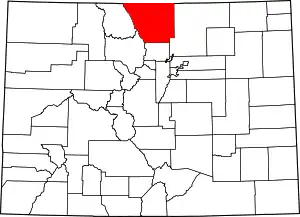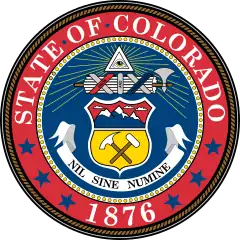Fort Collins, Colorado
The City of Fort Collins is the Home Rule Municipality that is the county seat and the most populous municipality of Larimer County, Colorado, United States.[8] Fort Collins is the principal city of the Fort Collins, CO Metropolitan Statistical Area and is a major city of the Front Range Urban Corridor. Situated on the Cache La Poudre River along the Colorado Front Range, Fort Collins is located 56 mi (90 km) north of the Colorado State Capitol in Denver. With a 2019 estimated population of 170,243,[6] it is the fourth most populous city in Colorado after Denver, Colorado Springs, and Aurora. Fort Collins is a midsize college city, home to Colorado State University and Front Range Community College's Larimer campus.
Fort Collins, Colorado | |
|---|---|
Home Rule Municipality[1] | |
| City of Fort Collins[1] | |
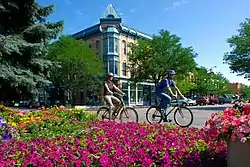 Downtown "Old Town" Fort Collins. | |
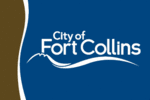 Flag | |
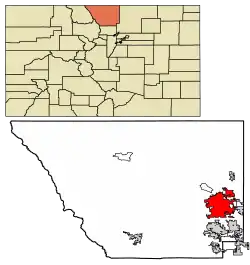 Location of the City of Fort Collins in Larimer County, Colorado. | |
 Fort Collins Location of the City of Fort Collins in the United States. | |
| Coordinates: 40°33′33″N 105°4′41″W | |
| Country | |
| State | |
| County | Larimer County[2] |
| City | Fort Collins[1] |
| Commissioned | 1864 |
| Incorporated | February 12, 1883[3] |
| Named for | United States Army Colonel William O. Collins |
| Government | |
| • Type | Home Rule Municipality[1] |
| • Mayor | Wade Troxell |
| • Mayor pro tem | Ross Cunniff |
| • City Manager | Darin Atteberry |
| Area | |
| • Total | 58.45 sq mi (151.38 km2) |
| • Land | 57.18 sq mi (148.10 km2) |
| • Water | 1.27 sq mi (3.28 km2) 1.27% |
| Elevation | 5,003 ft (1,525 m) |
| Population | |
| • Total | 143,986 |
| • Estimate (2019)[6] | 170,243 |
| • Density | 2,977.21/sq mi (1,149.50/km2) |
| Time zone | UTC−7 (MST) |
| • Summer (DST) | UTC−6 (MDT) |
| ZIP Codes[7] | 80521–80528 |
| Area code | 970 |
| FIPS code | 08-27425 |
| GNIS feature ID | 0204673 |
| Highways | I-25, US 287, SH 1, SH 14 |
| Website | fcgov |
History
Fort Collins was founded as a military outpost of the United States Army in 1864. It succeeded a previous encampment, known as Camp Collins, on the Cache La Poudre River, near what is known today as Laporte. Camp Collins was erected during the Indian wars of the mid-1860s to protect the Overland mail route that had been recently relocated through the region. Travelers crossing the county on the Overland Trail would camp there, but a flood destroyed the camp in June 1864.[9] Afterward, the commander of the fort wrote to the commandant of Fort Laramie in southeast Wyoming, Colonel William O. Collins, suggesting that a site several miles farther down the river would make a good location for the fort. The post was manned originally by two companies of the 11th Ohio Volunteer Cavalry and never had walls.[10]
.jpg.webp)

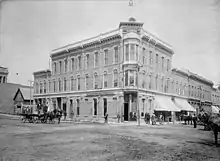
Settlers began arriving in the vicinity of the fort nearly immediately. The fort was decommissioned in 1867. The original fort site is now adjacent to the present historic "Old Town" portion of the city. The first school and church opened in 1866, and the town was platted in 1867. The civilian population of Fort Collins, led by local businessman Joseph Mason, led an effort to relocate the county seat to Fort Collins from LaPorte, and they were successful in 1868.[10]
The city's first population boom came in 1872, with the establishment of an agricultural colony. Hundreds of settlers arrived, developing lots just south of the original Old Town. Tension between new settlers and earlier inhabitants led to political divisions in the new town, which was incorporated in 1873. Although the Colorado Agricultural College was founded in 1870, the first classes were held in 1879.[11]
The 1880s saw the construction of a number of elegant homes and commercial buildings and the growth of a distinctive identity for Fort Collins. Stone quarrying, sugar-beet farming, and the slaughter of sheep were among the area's earliest industries. Beet tops, an industry supported by the college and its associated agricultural experiment station, proved to be an excellent and abundant food for local sheep,[12] and by the early 1900s the area was being referred to as the "Lamb feeding capital of the world". In 1901 the Great Western sugar processing plant was built in the neighboring city of Loveland.[13]

Although the city was affected by the Great Depression and simultaneous drought,[14] it nevertheless experienced slow and steady growth throughout the early part of the twentieth century.[15] During the decade following World War II, the population doubled and an era of economic prosperity occurred. Old buildings were razed to make way for new, modern structures. Along with revitalization came many changes, including the closing of the Great Western sugar factory in 1955, and a new city charter, adopting a council-manager form of government in 1954.[16] Similarly, Colorado State University's enrollment doubled during the 1960s,[17] making it the city's primary economic force by the end of the century.
Fort Collins gained a reputation as a very conservative city in the twentieth century, with a prohibition of alcoholic beverages, a contentious political issue in the town's early decades,[18] being retained from the late 1890s until student activism helped bring it to an end in 1969.[17] During that same period, civil rights activism and anti-war disturbances heightened tensions in the city, including the burning of several buildings on the CSU campus.[19]
During the late 20th century, Fort Collins expanded rapidly to the south, adding new development, including several regional malls.[19] Management of city growth patterns became a political priority during the 1980s, as well as the revitalization of Fort Collins' Old Town with the creation of a Downtown Development Authority.[20] In late July 1997, the city experienced a flash flood after and during a 31-hour period when 10–14 in (250–360 mm) of rain fell. The rainfall was the heaviest on record for an urban area of Colorado.[21] Five people were killed and $5 million in damages were dealt to the city. The waters flooded Colorado State University's library and brought about $140 million in damages to the institution.[22]
Geography
Fort Collins is situated at the base of the Rocky Mountain foothills of the northern Front Range, approximately 60 miles (97 km) north of Denver, Colorado, and 45 miles (72 km) south of Cheyenne, Wyoming. Elevation is 4,982 ft (1,519 m) above sea level. Geographic landmarks include Horsetooth Reservoir and Horsetooth Mountain—so named because of a tooth-shaped granite rock that dominates the city's western skyline. Longs Peak can also clearly be seen on a clear day to the southwest of the city.
The Cache La Poudre River and Spring Creek run through Fort Collins.
Climate
Located along the Front Range of the Rocky Mountains, Fort Collins experiences a semi-arid climate (Köppen BSk), with four distinct seasons and low annual precipitation. Summers range from mild to hot, with low humidity and afternoon thunderstorms that frequently threaten but only occasionally deliver rain. Winters range from mild to moderately cold. The city receives much sunshine, with 300 days of sunshine per year and 19 days with 90° + weather. The average temperature in July, the warmest month, is 71 °F (22 °C). The average temperature in January, the coldest month, is 29 °F (−2 °C). Annual snowfall averages 59 inches (1.5 m), and can occur from early September through the end of May. Average precipitation overall is 15.9 inches (400 mm).
| Climate data for Fort Collins, Colorado (1981–2010 normals) | |||||||||||||
|---|---|---|---|---|---|---|---|---|---|---|---|---|---|
| Month | Jan | Feb | Mar | Apr | May | Jun | Jul | Aug | Sep | Oct | Nov | Dec | Year |
| Record high °F (°C) | 73 (23) |
76 (24) |
81 (27) |
89 (32) |
97 (36) |
102 (39) |
103 (39) |
100 (38) |
97 (36) |
88 (31) |
81 (27) |
76 (24) |
103 (39) |
| Average high °F (°C) | 44.2 (6.8) |
46.5 (8.1) |
54.7 (12.6) |
62.2 (16.8) |
71.1 (21.7) |
80.4 (26.9) |
86.6 (30.3) |
84.0 (28.9) |
75.9 (24.4) |
63.9 (17.7) |
51.4 (10.8) |
42.8 (6.0) |
63.6 (17.6) |
| Average low °F (°C) | 17.5 (−8.1) |
20.4 (−6.4) |
27.7 (−2.4) |
35.1 (1.7) |
44.1 (6.7) |
52.2 (11.2) |
58.0 (14.4) |
56.3 (13.5) |
47.1 (8.4) |
35.9 (2.2) |
25.6 (−3.6) |
17.2 (−8.2) |
36.4 (2.4) |
| Record low °F (°C) | −38 (−39) |
−41 (−41) |
−31 (−35) |
−10 (−23) |
12 (−11) |
29 (−2) |
36 (2) |
32 (0) |
18 (−8) |
−8 (−22) |
−21 (−29) |
−35 (−37) |
−41 (−41) |
| Average precipitation inches (mm) | 0.40 (10) |
0.42 (11) |
1.60 (41) |
2.06 (52) |
2.43 (62) |
2.17 (55) |
1.71 (43) |
1.60 (41) |
1.33 (34) |
1.15 (29) |
0.76 (19) |
0.50 (13) |
16.13 (410) |
| Average snowfall inches (cm) | 7.3 (19) |
6.8 (17) |
12.1 (31) |
6.0 (15) |
0.7 (1.8) |
0 (0) |
0 (0) |
0 (0) |
0.9 (2.3) |
3.6 (9.1) |
8.6 (22) |
8.4 (21) |
54.4 (138.2) |
| Average precipitation days (≥ 0.01 in) | 4.1 | 4.9 | 6.4 | 8.6 | 11.2 | 10.0 | 9.0 | 9.4 | 7.6 | 6.3 | 5.2 | 4.5 | 87.2 |
| Average snowy days (≥ 0.1 in) | 4.4 | 5.0 | 5.3 | 3.1 | 0.4 | 0 | 0 | 0 | 0.4 | 1.4 | 4.1 | 4.7 | 28.8 |
| Source: NOAA[23] | |||||||||||||
Demographics
| Historical population | |||
|---|---|---|---|
| Census | Pop. | %± | |
| 1880 | 1,356 | — | |
| 1890 | 2,011 | 48.3% | |
| 1900 | 3,053 | 51.8% | |
| 1910 | 8,210 | 168.9% | |
| 1920 | 8,755 | 6.6% | |
| 1930 | 11,489 | 31.2% | |
| 1940 | 12,251 | 6.6% | |
| 1950 | 14,937 | 21.9% | |
| 1960 | 25,027 | 67.6% | |
| 1970 | 43,337 | 73.2% | |
| 1980 | 65,092 | 50.2% | |
| 1990 | 87,758 | 34.8% | |
| 2000 | 118,652 | 35.2% | |
| 2010 | 143,986 | 21.4% | |
| 2019 (est.) | 170,243 | [6] | 18.2% |
| U.S. Decennial Census[24] | |||
Fort Collins is the fourth most populous city in Colorado and the 158th most populous city in the United States. The Census Bureau estimates that the city's population was 161,175 in 2015, the population of the Fort Collins-Loveland Metropolitan Statistical Area was 310,487 (151st most populous MSA), and the population of the Front Range Urban Corridor was 4,495,181.
As of the census[25] of 2000, there were 118,652 people, 45,882 households, and 25,785 families residing in the city. The population density was 2,549.3 people per square mile (984.4/km2). There were 47,755 housing units at an average density of 1,026.0 per square mile (396.2/km2). The racial makeup of the city was 82.4% White, 3.01% Black or African American, 0.60% Native American, 2.48% Asian, 0.12% Pacific Islander, 3.61% from other races, and 2.53% from two or more races. Hispanic or Latino of any race were 10.79% of the population.
There were 45,882 households, out of which 29.0% had children under the age of 18 living with them, 44.9% were married couples living together, 7.9% had a female householder with no husband present, and 43.8% were non-families. 26.0% of all households were made up of individuals, and 5.9% had someone living alone who was 65 years of age or older. The average household size was 2.45 and the average family size was 3.01.
In the city, the population was spread out, with 21.5% under the age of 18, 22.1% from 18 to 24, 31.5% from 25 to 44, 17.0% from 45 to 64, and 7.9% who were 65 years of age or older. The median age was 28 years. For every 100 females, there were 100.9 males. For every 100 females age 18 and over, there were 99.7 males.
The median income for a household in the city was $64,459, and the median income for a family was $110,332. Males had a median income of $60,856 versus $48,385 for females. The per capita income for the city was $32,133. About 5.5% of families and 14.0% of the population were below the poverty line, including 8.3% of those under age 18 and 5.8% of those age 65 or over.
Economy
Major industries and commercial activity
Fort Collins' economy has a mix of manufacturing and service-related businesses. Fort Collins manufacturing includes Woodward Governor, Anheuser-Busch, and Otterbox. Many high-tech companies have relocated to Fort Collins because of the resources of Colorado State University and its research facilities. Hewlett Packard, Intel, AMD, Broadcom, Beckman Coulter, National Semiconductor, LSI, Microsoft, Rubicon Water and Pelco all have offices in Fort Collins. Other industries include clean energy, bioscience, and agri-tech businesses.
According to the city's 2017 Comprehensive Annual Financial Report,[26] the top employers are:
| # | Employer | # of Employees |
|---|---|---|
| 1 | Colorado State University | 7,829 |
| 2 | Poudre R-1 School District | 4,394 |
| 3 | Poudre Valley Hospital (UCHealth) | 4,288 |
| 4 | City of Fort Collins | 1,992 |
| 5 | Larimer County | 1,855 |
| 6 | Broadcom Inc. | 1,244 |
| 7 | Woodward, Inc. | 1,201 |
| 8 | Employment Solutions | 868 |
| 9 | Otter Products, LLC | 826 |
| 10 | Colorado Department of Agriculture | 789 |
Regional economic development partners include the City of Fort Collins Economic Health Office, Northern Colorado Economic Development Corporation, Small Business Development Center, and Rocky Mountain Innovation Initiative (RMI2).
Retail
The city's major shopping mall is The Shops at Foothills.
Sustainability programs
FortZED was a zero energy district encompassing the Downtown area of Fort Collins and the main campus of Colorado State University.[27] The district's public-private partnerships employed smart grid and renewable energy technologies to manage the local use and supply of energy. FortZED relied upon energy demand management techniques to encourage use of energy at the most efficient times.
Federal, state, and local funding made the project a reality. The U.S. Department of Energy contributed $6.3 million and the Colorado Department of Local Affairs provided $778,000. Locally, private companies and foundations committed nearly $8 million.
The program ended in 2017 after a majority of its projects had been completed.[28]
Arts and culture
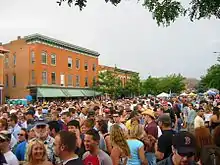

Much of Fort Collins's culture is centered around the students of Colorado State University. The city provides school year residences for its large college-age population; there is a local music circuit which is influenced by the college town atmosphere and is home to a number of well known microbreweries. The Downtown Business Association hosts a number of small and large festivals each year in the historic Downtown district, including Bohemian Nights at NewWestFest in late summer, which features local cuisine, music, and businesses. The Fort Collins Lincoln Center is home to the Fort Collins Symphony Orchestra and regularly attracts national touring companies of Broadway plays.
Brewing and cycling figure in local culture. The Colorado Brewer's Festival is held in late June annually in Fort Collins. The festival features beers from as many as 45 brewers from the state of Colorado and averages around 30,000 attendees. New Belgium Brewing Company hosts the Tour de Fat which draws over 20,000 people riding bikes and dressing in costume.
The Colorado Marathon is a yearly event running down the Poudre Canyon and finishing in downtown Fort Collins. The FORTitude 10K run, a partner running event of the Bolder Boulder, is held on Labor Day each year. The Horsetooth Half Marathon has been a fixture of the local running scene since 1973.[29]
The Fort Collins Museum, established in 1941, is a regional center focusing on the culture and history of Fort Collins and the surrounding area. The Fort Collins Museum houses over 30,000 artifacts and features temporary and permanent exhibits, on-going educational programs and events, and is home to four historic structures located in the outdoor Heritage Courtyard.
The arts are represented by The Center for Fine Art Photography, University Center for the Arts, Fort Collins Museum of Art (FCMOA), and the Bas Bleu Theatre Company. The Arts Incubator of the Rockies (AIR), founded in Fort Collins in 2012, was acquired in 2016 by Berea College in Kentucky, where it became part of the College Crafts Program.[30]
Parks and recreation
The Gardens on Spring Creek is an 18-acre (7.3 ha) botanical garden. The site includes several themed gardens ranging from a children's garden to a rock garden, to several themed demonstration gardens.[31]
There are also many parks in Fort Collins including community parks and neighborhood parks, totaling 875 acres (354 ha) of developed park areas.[32] Some of these parks have facilities such as public tennis courts, frisbee golf courses, golf courses, dog parks, baseball diamonds, basketball courts and picnic shelters. In total, there are 6 community parks.[32] These include City Park, Edora Park, Fossil Creek Park, Lee Martinez Park, Rolland Moore Park, and Spring Canyon Park.[33] There are also many smaller neighborhood parks. These parks often host events such as marathons, community activities and holiday celebrations.[34] Additionally, Fort Collins is home to a whitewater park alongside the Poudre River.
The city purchased the Soapstone Prairie Natural Area, a park and conservation area north of the city. Within the park is the Lindenmeier Site, a stratified multi-component archaeological site most famous for its Folsom component.
Government
| Mayor | Wade Troxell |
| District 1 | Susan Gutowsky |
| District 2 | Julie Pignataro |
| District 3 | Ken Summers |
| District 4 | Vacant |
| District 5 | Ross Cunniff, Mayor Pro Tempore |
| District 6 | Emily Gorgol |
Fort Collins has a council-manager form of government. The mayor, who serves a two-year term and stands for election in municipal elections held in April of odd-numbered years, presides over a seven-member City Council. The current mayor of Fort Collins is Wade Troxell, who was re-elected to a third term in April 2019.[36] The six remaining council members are elected from districts for staggered four-year terms; odd-numbered districts are up for election in April 2021 and even-numbered districts in April 2023.
Fort Collins is the largest city in Colorado's 2nd Congressional district, and is represented in Congress by Representative Joe Neguse (Democrat). On the state level, the city lies in the 14th district of the Colorado Senate, represented by Joann Ginal and is split between the 52nd and 53rd districts of the Colorado House of Representatives, represented by Cathy Kipp and Jennifer Arndt, respectively. All three of Fort Collins' state legislators are Democrats. Fort Collins is additionally the county seat of Larimer County, and houses county offices and courts.
Education
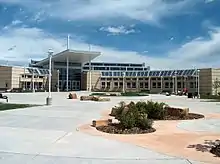
K–12 public education is provided through Poudre School District (PSD). The district operates and manages the public schools in the city of Fort Collins, as well as in the surrounding towns of Wellington, Timnath, Windsor, Laporte and Livermore. The district is one of the fastest growing in Northern Colorado, adding 500 students — about the size of an elementary school — each year. To accommodate growth, the district plans to build three new schools in the next few years.[37]
Poudre School District includes four comprehensive high schools that serve neighborhoods around Fort Collins, including Fort Collins High School, Rocky Mountain High School, Poudre High School, Fossil Ridge High School. The district also operates four alternative high schools: Centennial High School, Polaris School for Expeditionary Learning, Poudre Community Academy and Poudre School District Global Academy, a dual in-person/online school. Additionally, four public charter schools are chartered through PSD, including Ridgeview Classical Schools, and Liberty Common High School, Mountain Sage Community School and Fort Collins Montessori School.
The Poudre School District is also home to ten middle schools (Lesher Middle IB World School, Blevins Middle School, Boltz Middle School, Cache La Poudre Middle School, Kinard Core Knowledge Middle School, Lincoln IB World Middle School, Polaris Expeditionary Learning School, Preston Middle School, Webber Middle School, and Wellington Middle School) and 32 elementary schools.
In addition to PSD schools, several state charter schools serve Fort Collins, including Academy of Arts and Knowledge,[38] Colorado Early Colleges,[39] and Global Village Academy. Private schools include Heritage Christian Academy, Rivendell School,[40] and St. Joseph's Catholic School.
Higher education
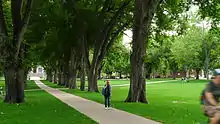
Colorado State University heads up the choices in higher education. Front Range Community College also maintains a campus in the city, and grants associate's degrees in arts, science, general studies, and applied science. The college offers 17 high school vocational programs and more than 90 continuing education classes.
The Institute of Business & Medical Careers provides professional training in the business and medical professions.[41] The institute's first campus was established in the city in 1987.
The Fort Collins Public Library was established in 1900, the sixth public library in the state. The city received $12,500 from philanthropist Andrew Carnegie to build the library, with the condition that it would be maintained as a free public library. It was completed in 1904 at a total cost of approximately $15,000.[42] The library formed a regional library district through a ballot measure in 2006. It has been renamed Poudre River Public Library District. The district operates three branches: the Old Town Library is located in downtown Fort Collins; the Harmony library is hosted at Front Range Community College; and the Council Tree Library, which opened in 2009, is at the Front Range Village Shopping Center. The library participates in cooperative projects with the local school district and Colorado State University.
Fort Collins has a range of research institutes. Facilities are maintained by the Centers for Disease Control and Prevention's Division of Vector-Borne Diseases,[43] the Center for Advanced Technology and the Colorado Water Resource Research Institute. Other facilities include the Cooperative Institute for Research in the Atmosphere, the Institute for Scientific Computing, the U.S. Forest Service Experimental Station, the National Center for Genetic Resources Preservation (NCGRP), and the U.S.D.A. Crops Research Laboratory.
Media
Transportation
Air travel
Allegiant Air offered regular passenger airplane service into the nearby Fort Collins / Loveland Airport, but the airline ended commercial flights to this airport. Elite Airways resumed commercial air service at the airport on August 27, 2015, providing non-stop flights to the Chicago Rockford International Airport in Illinois. The airline ended service to the airport in 2017. [44] Denver International Airport, which is 70 miles (110 km) to the south, is served by twenty three airlines.
The city's former general aviation airport, known as Fort Collins Downtown Airport (3V5), opened in 1966 and closed in 2006.[45]
Streets
Fort Collins's downtown streets form a grid with Interstate 25 running north and south on the east side of the city. Many of the streets are named after the town's founders.[46] U.S. Highway 287 becomes College Avenue inside the city and is the busiest street; It runs north and south, effectively bisecting the city, and serving as the east–west meridian, while Mountain Avenue is the north–south. SH 14 runs concurrent with US 287 at the northern city limit to Jefferson Street, running southeast along Jefferson (later turning into Riverside Avenue), then turning east onto Mulberry Street where it goes east out of the city after an interchange with Interstate 25.
Transit and taxi
Fort Collins also once had a municipally owned trolley service with three branches from the intersection of Mountain and College avenues. The trolley was begun in 1907 by the Denver and Interurban Railroad, which had the intention of connecting the Front Range of Colorado.[47] It was closed in 1951 after ceasing to be profitable. In 1983–84, a portion of the Mountain Avenue line and one of the original trolley cars, Car 21, were restored as a heritage trolley service, under the same name used by the original system, the Fort Collins Municipal Railway.[48] This has been in operation since the end of 1984 on weekends and holidays in the spring and summer, as a tourist and cultural/educational attraction. A second car, number 25, was returned to service on July 4, 2020.[49] A small fee applies to ride.
The city bus system, known as Transfort, operates more than a dozen routes throughout Fort Collins Monday through Saturday, except major holidays.
The MAX Bus Rapid Transit is a bus rapid transit that provides service on the Mason Corridor Transitway parallel to College Avenue from Downtown Fort Collins to a transit center just south of Harmony Road. The trip takes approximately 15 minutes from end to end with various stops between. The service began in May 2014.[50] The Mason Corridor and the Mason Express are intended to be the center of future transit-oriented development.
Fort Collins is connected to Loveland, Berthoud, Longmont, and Boulder via the FLEX regional bus route.
Greeley-Evans Transit operates a service called the Poudre Express connecting Fort Collins with Windsor and Greeley.
Bustang provides additional intercity transportation for the city. Fort Collins is the northernmost stop on the North Line, which connects southward to Denver.
Taxi service is provided by Northern Colorado Yellow Cab. Pedicabs are also available from HopON LLC and Dream team Pedicabs.[51]
Cycling
Bicycling is a popular and viable means of transportation in Fort Collins. There are more than 280 miles (450 km) of designated bikeways in Fort Collins, including on-street designated bike lanes, and the Spring Creek and Poudre River Trails, both paved. There is also a dirt trail, the 5.8-mile (9.3 km) Foothills Trail, parallel to Horsetooth Reservoir from Dixon Reservoir north to Campeau Open Space and Michaud Lane.
The Fort Collins Bicycle Library lends bicycles to visitors, students, and residents looking to explore the city of Fort Collins. There are self-guided tours from the "Bike the Sites" collection, including a Brewery Tour, Environmental Learning Tour, and the Historic Tour. The Bike Library is centrally located in the heart of downtown Fort Collins in Old Town Square. The City of Fort Collins also encourages use of alternative transportation, like cycling and using public transit, though FC Moves.
In 2009, the Fort Collins-Loveland metropolitan statistical area (MSA) ranked as the third highest in the United States for percentage of commuters who biked to work (5.6 percent).[52]
In 2013, the League of American Bicyclists designated Fort Collins a Platinum-level Bicycle Friendly Community – one of four in the United States.[53] In 2018, the PeopleForBikes foundation named Fort Collins the no. 1 city in the United States for cycling.[54]
Electric scooters
In early 2019, the City of Fort Collins and Colorado State University (CSU) were preparing regulations for the eventual arrival of electric scooters, in order to avoid the problems other cities have had with these.[55] After a City Council session on Feb. 19, the City Government approved scooter regulations, such as specific areas in which scooters must be parked and the observation of dismount zones.[56] in October 2019, The City of Fort Collins and CSU announced a 12-month e-scooter share pilot program partnering with Bird company.[57][58]
Infrastructure
Commercial shipping
Parcel service for Fort Collins is provided by FedEx, Airport Express, DHL, Burlington Air Express, UPS, and Purolator. Fort Collins has two-day rail freight access to the West Coast or the East Coast and has eight motor freight carriers. Many local industrial sites have rail freight spur service. The city is served by Union Pacific and Burlington Northern Santa Fe railroads.
Facilities
- NIST time signal transmitters WWV and WWVB are near the city[59]
- Poudre Valley Hospital has helped make Fort Collins into a regional health care center
- The National Center for Genetic Resources Preservation (NCGRP) (Human Genome Project)
- The city is the headquarters of Roosevelt National Forest
- Atmospheric Chemistry and Aerosol Laboratory
- Centers for Disease Control and Prevention: Division of Vector-Borne Diseases
- USDA Seed Lab Storage
- Headquarters for SCUBA Schools International (SSI)
- National Wildlife Research Center
- USDA Animal and Plant Health Inspection Service Western Regional Headquarters
Police
Notable people
- Wayne Allard, former U.S. senator from Colorado
- Scott Anderson, racing driver
- James B. Arthur, pioneer, entrepreneur, mayor, councilman, Colorado state senator[60]
- John Ashton, actor
- Carol Berg, fantasy author
- Biota, music ensemble
- Frank Caeti, repertory cast member on sketch comedy series MADtv
- Allen Bert Christman, a cartoonist and American Volunteer Group pilot killed in Rangoon, Burma, during World War II
- Jon Cooper, center for NFL's Minnesota Vikings
- Joy Davidson, opera singer
- Janay DeLoach, professional track and field athlete and Olympian
- Rick Dennison, NFL linebacker
- Jeff Donaldson, NFL defensive back
- Becca Fitzpatrick, author
- Lamar Gant, powerlifter
- Harper Goff, artist, musician, and actor
- Marco Gonzales, Major League Baseball player
- Georgia Gould, professional mountain bike and Cyclo-cross racer
- Temple Grandin, author, professor, subject of film Temple Grandin
- JD Hammer (born 1994), Major League Baseball pitcher for the Philadelphia Phillies
- Jon Heder, title character in 2004's Napoleon Dynamite
- Ed Herman, mixed martial artist fighting for the UFC
- Katie Herzig, folk musician
- Immortal Dominion, heavy metal band known for soundtrack to Teeth
- Korey Jones, CFL player
- Jake Lloyd, young Anakin Skywalker in 1999's Star Wars: Episode I – The Phantom Menace
- Sonny Lubick, former head football coach at Colorado State University
- Ross Marquand, actor best known for portraying Aaron in The Walking Dead
- David Mattingly, science fiction illustrator
- Hattie McDaniel, first African-American to win an Academy Award (Best Supporting Actress 1939)
- Darnell McDonald, Major League Baseball player
- Donzell McDonald, former Major League Baseball player
- Mark D. Miller, photographer
- Edward S. Montgomery, journalist
- Pete Monty, NFL linebacker
- John Mortvedt, soil scientist and professor emeritus at Colorado State University
- Blake Neubert, artist
- Carl B. Olsen, U.S. Coast Guard rear admiral
- Holmes Rolston III, 2003 Templeton Prize winner
- Derek Vincent Smith, electronic music artist who performs under name "Pretty Lights"
- Bill Stevenson, musician (Descendents), record producer, and owner of The Blasting Room Studios
- Pat Stryker, billionaire heiress and philanthropist
- Thomas Sutherland, Colorado State professor and former Beirut hostage
- Ryan Sutter, bachelor chosen as a groom by Trista Rehn in 2003's The Bachelorette
- Shane Swartz, boxer
- Derek Theler, actor in ABC family show Baby Daddy[61]
- Haeley Vaughn, top 25 finalist of American Idol
- Byron Raymond White, Associate Justice of the Supreme Court
- Jason Wingate, composer[62]
- Ben Woolf, actor
- Darwood Kenneth Smith, Actor, Known for Waldo in the Our Gang short subjects series from 1937 to 1940.
In popular culture
Fort Collins is known along with Marceline, Missouri as one of the towns that inspired the design of Main Street, U.S.A. inside the main entrance of the many "Disneyland"-style parks run by The Walt Disney Company around the world.[63]
Fort Collins was the setting of the infamous balloon boy hoax of October 15, 2009.[64]
Acclaim
- In 2006, Money ranked Fort Collins as the best place to live in America.[65]
- In 2011, Allstate Insurance listed Fort Collins as "America's Safest Driving City" in their annual "Best Drivers Report".[66]
- In 2012, the city was listed among the 10 best places to retire in the U.S. by CBS Money Watch.[67]
- In 2015, Fort Collins ranked No. 10 on Forbes' list of the Best Places for Business and Careers.[68]
- In 2017, Fort Collins ranked No. 4 on Forbes' list of the 25 Happiest Cities in America.[69]
See also
References
- "Active Colorado Municipalities". State of Colorado, Colorado Department of Local Affairs, Division of Local Government. Retrieved January 26, 2021.
- "Colorado Counties". State of Colorado, Colorado Department of Local Affairs, Division of Local Government. Retrieved January 26, 2021.
- "Colorado Municipal Incorporations". State of Colorado, Department of Personnel & Administration, Colorado State Archives. December 1, 2004. Archived from the original on December 2, 2010. Retrieved September 2, 2007.
- "2019 U.S. Gazetteer Files". United States Census Bureau. Retrieved July 1, 2020.
- "U.S. Census website". United States Census Bureau. Retrieved November 6, 2014.
- "Population and Housing Unit Estimates". Retrieved May 21, 2020.
- "ZIP Code Lookup". United States Postal Service. Archived from the original (JavaScript/HTML) on November 4, 2010. Retrieved September 16, 2007.
- "Find a County". National Association of Counties. Archived from the original on May 31, 2011. Retrieved 2011-06-07.
- "Flooding Timeline in Fort Collins". Archived from the original on January 25, 2009. Retrieved September 28, 2007.
- "Fort Collins Time Line 1860". Fort Collins Local History Archive. Archived from the original on July 10, 2011. Retrieved March 24, 2007.
- "History of Colorado State University". Archived from the original on October 12, 2007. Retrieved May 12, 2007.
- "Fort Collins Time Line 1890". Fort Collins Local History Archive. Archived from the original on July 10, 2011. Retrieved March 24, 2007.
- "Fort Collins Time Line 1900". Fort Collins Local History Archive. Archived from the original on July 10, 2011. Retrieved March 24, 2007.
- "Fort Collins Time Line 1930". Fort Collins Local History Archive. Archived from the original on July 10, 2011. Retrieved March 24, 2007.
- "Fort Collins Time Line 1940". Fort Collins Local History Archive. Archived from the original on July 10, 2011. Retrieved March 24, 2007.
- "Fort Collins Time Line 1950". Fort Collins Local History Archive. Archived from the original on July 10, 2011. Retrieved March 24, 2007.
- "Fort Collins Time Line 1960". Fort Collins Local History Archive. Archived from the original on July 10, 2011. Retrieved March 24, 2007.
- "Fort Collins Time Line 1880". Fort Collins Local History Archive. Archived from the original on July 10, 2011. Retrieved March 24, 2007.
- "Fort Collins Time Line 1970". Fort Collins Local History Archive. Archived from the original on July 10, 2011. Retrieved March 24, 2007.
- "Fort Collins Time Line 1980". Fort Collins Local History Archive. Archived from the original on July 10, 2011. Retrieved March 24, 2007.
- Grigg, Neil S.; Nolan J. Doesken; David M. Frick; Mike Grimm; 4 Marsha Hilmes; Thomas B. McKee; Kevin A. Oltjenbruns (September–October 1999). "Fort Collins Flood 1997: Comprehensive View of an Extreme Event" (PDF). Journal of Water Resources Planning and Management. American Society of Civil Engineers. 125 (5): 255–262. doi:10.1061/(ASCE)0733-9496(1999)125:5(255). ISSN 1943-5452. Archived from the original (PDF) on March 15, 2013. Retrieved April 23, 2012.
- "Fort Collins July 28, 1997". University Corporation for Atmospheric Research. Retrieved April 23, 2012.
- "NowData – NOAA Online Weather Data". National Oceanic and Atmospheric Administration. Retrieved March 1, 2012.
- "Census of Population and Housing". Census.gov. Retrieved June 4, 2015.
- "U.S. Census website". United States Census Bureau. Retrieved 2008-01-31.
- "Fort Collins, Colorado CAFR 2017" (PDF). fcgov.com. Retrieved February 27, 2019.
- FortZED.com
- https://www.coloradoan.com/story/news/2017/09/10/fort-collins-zero-energy-district-powers-down/646429001/
- https://horsetooth-half.com/results-history/
- https://www.berea.edu/news/arts-incubator-program-acquired-berea-college-relocates-berea-kentucky/
- "Children's Garden: The Gardens on Spring Creek". City of Fort Collins. Retrieved April 6, 2020.
- http://www.fcgov.com/parks/
- http://www.fcgov.com/parks/map/
- "Your Guide to Community and Neighborhood Parks in Fort Collins [Interactive Map]". Northern Colorado Speaks. May 8, 2019. Retrieved March 17, 2020.
- "Home page for city council". City of Fort Collins. Archived from the original on March 27, 2009. Retrieved August 18, 2007.
- Coltrain, Nick (April 2, 2019). "Wade Troxell wins third term as Fort Collins mayor in City Council election". Coloradan. Denver, Colorado. Retrieved April 3, 2019.
- Kyle, Sarah (April 26, 2016). "PSD board approves plan to build schools". Fort Collins Coloradoan. Retrieved June 8, 2016.
- https://www.aakelementary.org/
- https://www.coloradoearlycolleges.org/
- https://www.rivendell-school.org/
- IBMC Purpose
- Hansen, James E. (1977). Democracy's college in the Centennial State: a history of Colorado State University. Fort Collins: Colorado State University. pp. 230–231.
- Division of Vector-Borne Diseases
- http://www.wrex.com/story/29278329/2015/06/09/rockford-airport-to-serve-denver-new-york-city
- "Valley Airport / Fort Collins Airpark / Fort Collins Downtown Airport (3V5)". Abandoned & Little-Known Airfields. December 11, 2009. Archived from the original on October 22, 2010.
- "Street Names Recall Early History: News Flashbacks: Fort Collins History Connection". history.fcgov.com. Retrieved February 24, 2019.
- "Fort Collins Municipal Railway - History". www.fortcollinstrolley.org. Retrieved November 12, 2018.
- Long, Raphael P. (April 1986). "Fort Collins Municipal Railway: Then and Now". Pacific RailNews, pp. 16–20. Glendale, CA: Interurban Press. ISSN 8750-8486.
- https://www.coloradoan.com/picture-gallery/news/2020/07/04/restored-fort-collins-trolley-returns-tracks-historic-two-car-trip/5377639002/?fbclid=IwAR3Y14qJUVmVgDxE0YvIdt-3Gu-BNRYZaF-qm_FKk69FAAEQQNJXCNHom7Y. Missing or empty
|title=(help) - "$87 million MAX project ready to roll in Fort Collins". May 9, 2014.
- http://www.northerncoloradoyellowcab.com
- "Commuting in the United States: 2009" (PDF). American Community Survey Reports. September 2011. Retrieved December 26, 2017.
- "New Platinum City in Latest Round of Bicycle Friendly Communities!". June 6, 2013. Archived from the original on June 29, 2013.
- "Fort Collins named No. 1 city for bikes". Loveland Reporter-Herald. May 23, 2018. Retrieved November 18, 2019.
- Trowbridge, Julia. "Fort Collins, CSU prepares for electric scooters". Rocky Mountain Collegian.
- Ye, Samantha. "City Council approves scooter regulations". Rocky Mountain Collegian.
- "Electric Scooters || Electric Scooters". www.fcgov.com. Retrieved November 14, 2019.
- Powell, Rebecca. "Bird scooters to launch in Fort Collins on Oct. 23". Coloradoan. Retrieved November 14, 2019.
- "NIST Radio Station WWVB". Retrieved March 18, 2014.
- James Arthur Website
- Corrinson, Michele (July 11, 2012). "Baby Daddy: Derek Theler Talks About His New Hit Show". College Magazine. Archived from the original on November 12, 2013. Retrieved September 19, 2013.
- Jason Wingate | Classical Composers Database
- "Local History Archive Larimer Legends - Old Town & Disneyland - City of Fort Collins, Colorado". Library.ci.fort-collins.co.us. Archived from the original on March 31, 2014. Retrieved March 1, 2014.
- "6-year-old Colorado boy found alive in attic after balloon lands". CNN. October 15, 2009. Archived from the original on October 18, 2009. Retrieved October 20, 2009.
- "Best Places to Live 2006". Money Magazine. July 2006. Archived from the original on November 14, 2010. Retrieved December 15, 2006.
- "Seventh Annual "Allstate America's Best Drivers Report" Reveals Safest Driving Cities". Allstate Insurance Company. September 1, 2011. Archived from the original on December 18, 2013. Retrieved January 2, 2014.
- "The 10 best places to retire". www.cbsnews.com. Retrieved July 22, 2019.
- "Best Places For Business and Careers - Forbes". Forbes. Retrieved August 18, 2016.
- Bloom, Laura Begley. "Ranked: The 25 Happiest Cities In America". Forbes. Retrieved November 2, 2017.
External links
| Wikimedia Commons has media related to Fort Collins, Colorado. |
| Wikivoyage has a travel guide for Fort Collins. |

